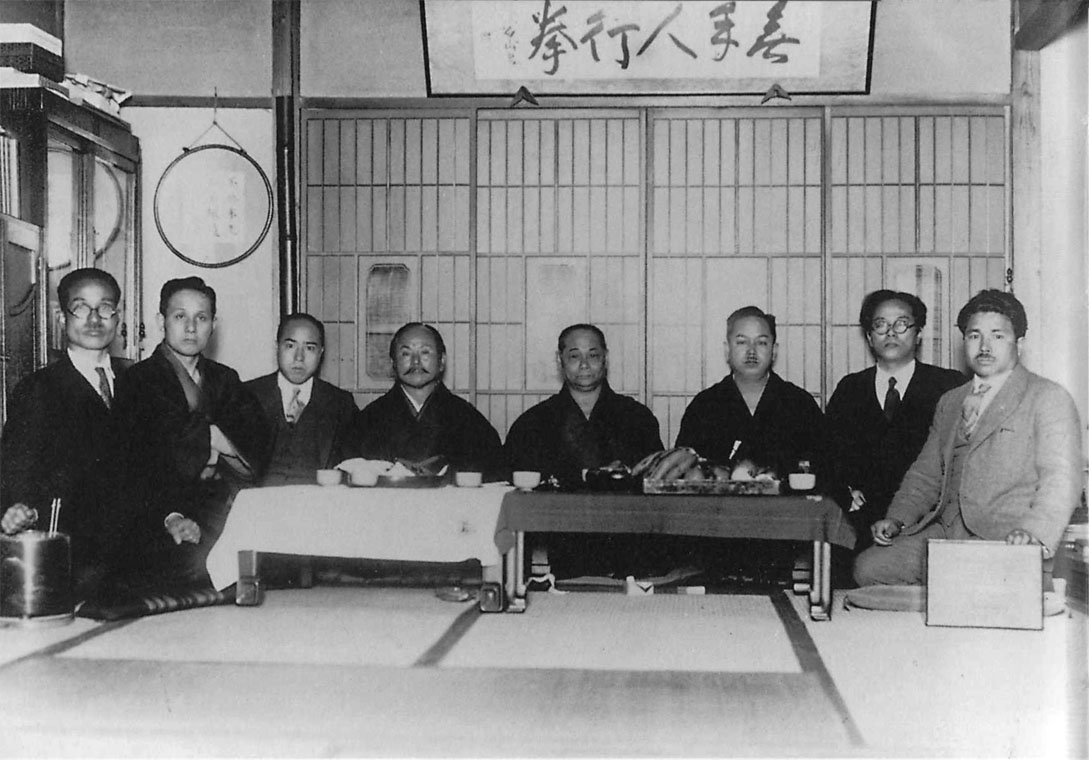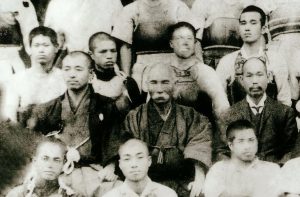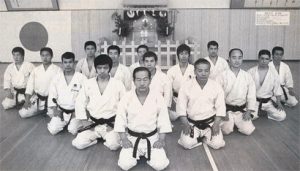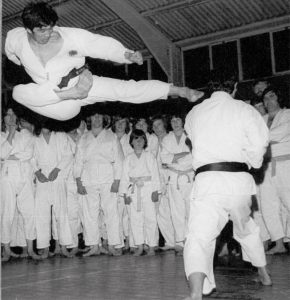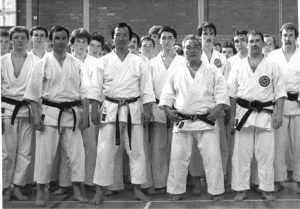The name of a few who influenced the development of the art over the years…
Kūsankū |
|
 |
Kūsankū (公相君) was a Chinese martial artist who is thought to have had a significant influence on all karate-derived martial arts. He lived in the 18th century. He learned the art of Ch’uan Fa in China from a Shaolin monk. Around 1756, he was sent to Ryukyu as an ambassador of the Qing Dynasty, and lived in the village of Kumemura, near Naha. He is thought to have created the Kanku kata. |
Kanga Sakugawa |
|
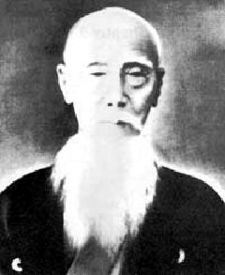 |
Kanga Sakugawa (佐久川 寛賀), also known as Tode Sakugawa,was a Ryūkyūan martial arts master and a major contributor to the development of Te, the precursor to modern Karate. He was born in 1733 and died in 1815. In 1750, Sakugawa began training under a Ryūkyūan monk, Peichin Takahara. He went on to train under Kusanku. He became such an expert that people referred to him as “Tōde” Sakugawa (Sakugawa “Chinese Hand”). |
Matsumura Sōkon |
|
 |
Matsumura Sōkon (松村 宗棍) was one of the original karate masters of Okinawa. He was born in 1809 and died in 1899. Born in Shuri, he started studying karate under the guidance of Sakukawa Kanga, who was somewhat reluctant but promised his father he would do so.Matsumura was recruited by the royal family of the Ryūkyū Kingdom in 1836 and he eventually became the chief martial arts instructor and bodyguard of the Okinawan King Shō Kō, and subsequent kings. His official travels took him to China where he studied Chuan Fa and brought what he learned back to Okinawa.Matsumura was given the title of “bushi” (“warrior”) by the Okinawan king – in recognition of his abilities and accomplishments in the martial arts. Described by Funakoshi as a sensei with a terrifying presence, Matsumura is said to have never been defeated in a duel. Tall, thin, and possessing a pair of unsettling eyes, Matsumura was described by his student Ankō Itosu as blindingly fast and deceptively strong.“With the fierceness of a tiger and the swiftness of a bird, an indomitable calmness makes subjugating any adversary effortless.“ |
Ankō Itosu |
|
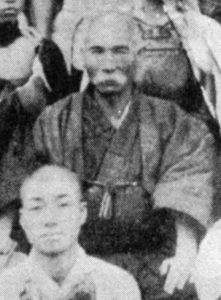 |
Ankō Itosu (糸洲 安恒) is considered by many as the father of modern karate – although this title is also often given to Gichin Funakoshi who spread the art throughout Japan.He was born in 1831 and died in 1915. He began his tode (karate) study under Nagahama Chikudun Pechin before joining Matsumura Sōkon. Part of Itosu’s training was makiwara practice. He once tied a leather sandal to a stone wall in an effort to build a better makiwara. After several strikes, the stone fell from the wall. After relocating the sandal several times, Itosu had destroyed the wall.He was instrumental in introducing karate into Okinawa’s schools at the beginning of the 20th century and developed a method to teach karate techniques to children, still in practice today. He introduced the Pinan kata (Heian) as learning steps for students, because he felt the older forms were too difficult for schoolchildren to learn. The five Pinan forms were (allegedly) inspired from kusanku (or kanku dai). He is also credited with creating the 3 Tekki, by breaking the Naihanchi kata.In 1908, Itosu wrote the influential “Ten Precepts (Tode Jukun) of Karate”.“When you train, do so as if on the battlefield. Your eyes should glare, shoulders drop, and body harden. You should always train with intensity and spirit and in this way you will naturally be ready.” |
Gichin Funakoshi |
|
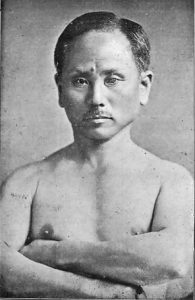 |
Gichin Funakoshi (船越 義珍) was born in 1868 and died in 1957. He is the founder of Shotokan Karate-Do, and is often referred to as the “father of modern karate”. A student of Anko Itosu and Anko Asato, he introduced karate to the Japanese mainland in 1922. He went on to teach karate at various Japanese universities, promoting the art around the country.In 1936, Funakoshi built the first Shōtōkan dojo (training hall) in Tokyo. He changed the name of karate to mean “empty hand” (空手) instead of “China hand” (唐手) as it was referred to in Okinawa – identical pronunciation. Funakoshi’s interpretation of the character kara in karate to mean “empty” (空) rather than “Chinese” (唐) was reported to have caused some issues in Okinawa, prompting Funakoshi to remain in Tokyo indefinitely.In 1949 Funakoshi’s students created the Japan Karate Association (JKA), with Funakoshi as the honorary head of the organization. However, in practise this organization was led by Masatoshi Nakayama. The JKA began formalizing Funakoshi’s teachings. Funakoshi was not supportive of all of the changes that the JKA eventually made to his karate style.Funakoshi published several books on karate including his autobiography, “Karate-Do: My Way of Life“. His legacy however, rests in a document containing his philosophies of karate training now referred to as the niju kun, or “twenty principles”. These rules are the key principles that all Shotokan practitioners should follow in an effort to “become better human beings”.“Karate is like boiling water: without heat, it returns to it’s tepid state.” |
Masatoshi Nakayama |
|
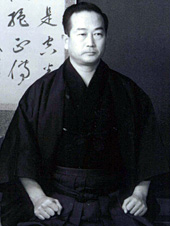 |
Masatoshi Nakayama (中山 正敏) was born in 1913 and died in 1987. He helped establish the Japan Karate Association (JKA) in 1949, and wrote many textbooks on karate, which served to popularize the art. For almost 40 years, until his death in 1987, Nakayama worked to spread Shotokan karate around the world.Nakayama entered Takushoku University in 1932 to study Chinese language. He had originally planned to train in kendo, but misread the schedule and arrived at karate training instead. He began learning karate under Gichin Funakoshi and his son Yoshitaka (also known as Gigō).In May 1949, he helped establish the Japan Karate Association (JKA), with Funakoshi appointed as formal head of the organization, and himself as Chief Instructor. In 1956, he began restructuring the Shotokan karate training program to follow both traditional karate and methods developed in modern sports sciences and established kata (patterns) and kumite (sparring) as tournament disciplines.“The essence of karate techniques is kime. The meaning of kime is an explosive attack to the target using the appropriate technique and maximum power in the shortest time possible… Training transforms parts of the body into weapons to be used freely and effectively. The quality necessary to accomplish this is self-control. To become a victor, one must first overcome his own self.” (Nakayama, M. Japan 1987. `Best Karate Volume 11’. Kodansha International Ltd.). |
Hirokazu Kanazawa |
|
 |
Hirokazu Kanazawa (金澤 弘和) was born in 1931. He is the Chief instructor and President of the Shotokan Karate-Do International Federation, an organisation he founded after he left the Japan Karate Association (JKA).He trained in judo during his school years and began training in karate whilst at Takushoku University under the then-head instructor of Shotokan karate, Masatoshi Nakayama as well as Gichin Funakoshi.He joined the JKA in 1956. He won the inaugural All Japan Karate Championship’s kumite (sparring) championship in 1957 and reportedly won the kumite competition with a broken hand.“One pure mind is better than one hundred techniques.” |
Keinosuke Enoeda |
|
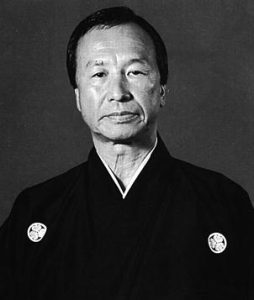 |
Keinosuke Enoeda (榎枝 慶之輔) was born in 1935 and died in 2003. He initially trained in kendo and judo, and only began studying karate at university. After graduating from university, Enoeda studied at the JKA honbu dojo in Tokyo under Masatoshi Nakayama. In 1961, he fought a notable tournament match against Keigo Abe, winning by decision after six extensions. He acquired the nickname Tora (“Tiger”) thanks to his fighting skills.In 1965, Enoeda travelled to England in an effort by the JKA to introduce karate abroad. He began teaching in Liverpool, before moving to London and teaching at the now famous Marshall Street dojo, near Carnaby Street in London – until his death on 29 March 2003.“The soul of Karate-do is peace and concern for all mankind. It is my wish that people who practice karate-do should always keep these things in mind : a modest heart, gentle attitude and peace for mankind. The spirit of ‘Karate ni sente nashi’ is thus fulfilled.” |
|
|
|
… |

